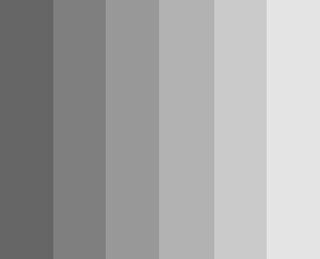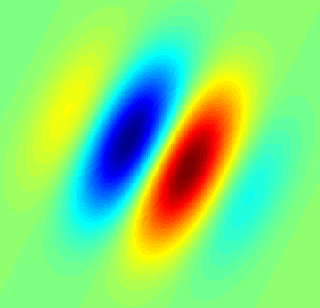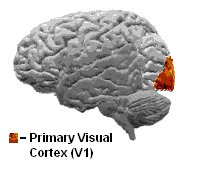Related Research Articles

The visual cortex of the brain is the area of the cerebral cortex that processes visual information. It is located in the occipital lobe. Sensory input originating from the eyes travels through the lateral geniculate nucleus in the thalamus and then reaches the visual cortex. The area of the visual cortex that receives the sensory input from the lateral geniculate nucleus is the primary visual cortex, also known as visual area 1 (V1), Brodmann area 17, or the striate cortex. The extrastriate areas consist of visual areas 2, 3, 4, and 5.

In neuroanatomy, the lateral geniculate nucleus is a structure in the thalamus and a key component of the mammalian visual pathway. It is a small, ovoid, ventral projection of the thalamus where the thalamus connects with the optic nerve. There are two LGNs, one on the left and another on the right side of the thalamus. In humans, both LGNs have six layers of neurons alternating with optic fibers.

Torsten Nils Wiesel is a Swedish neurophysiologist. With David H. Hubel, he received the 1981 Nobel Prize in Physiology or Medicine, for their discoveries concerning information processing in the visual system; the prize was shared with Roger W. Sperry for his independent research on the cerebral hemispheres.

David Hunter Hubel was an American Canadian neurophysiologist noted for his studies of the structure and function of the visual cortex. He was co-recipient with Torsten Wiesel of the 1981 Nobel Prize in Physiology or Medicine, for their discoveries concerning information processing in the visual system. For much of his career, Hubel worked as the Professor of Neurobiology at Johns Hopkins University and Harvard Medical School. In 1978, Hubel and Wiesel were awarded the Louisa Gross Horwitz Prize from Columbia University. In 1983, Hubel received the Golden Plate Award of the American Academy of Achievement.

A cortical column is a group of neurons forming a cylindrical structure through the cerebral cortex of the brain perpendicular to the cortical surface. The structure was first identified by Mountcastle in 1957. He later identified minicolumns as the basic units of the neocortex which were arranged into columns. Each contains the same types of neurons, connectivity, and firing properties. Columns are also called hypercolumn, macrocolumn, functional column or sometimes cortical module. Neurons within a minicolumn (microcolumn) encode similar features, whereas a hypercolumn "denotes a unit containing a full set of values for any given set of receptive field parameters". A cortical module is defined as either synonymous with a hypercolumn (Mountcastle) or as a tissue block of multiple overlapping hypercolumns.
The receptive field, or sensory space, is a delimited medium where some physiological stimuli can evoke a sensory neuronal response in specific organisms.

Motion perception is the process of inferring the speed and direction of elements in a scene based on visual, vestibular and proprioceptive inputs. Although this process appears straightforward to most observers, it has proven to be a difficult problem from a computational perspective, and difficult to explain in terms of neural processing.
Neuronal tuning refers to the hypothesized property of brain cells by which they selectively represent a particular type of sensory, association, motor, or cognitive information. Some neuronal responses have been hypothesized to be optimally tuned to specific patterns through experience. Neuronal tuning can be strong and sharp, as observed in primary visual cortex, or weak and broad, as observed in neural ensembles. Single neurons are hypothesized to be simultaneously tuned to several modalities, such as visual, auditory, and olfactory. Neurons hypothesized to be tuned to different signals are often hypothesized to integrate information from the different sources. In computational models called neural networks, such integration is the major principle of operation. The best examples of neuronal tuning can be seen in the visual, auditory, olfactory, somatosensory, and memory systems, although due to the small number of stimuli tested the generality of neuronal tuning claims is still an open question.
The normalization model is an influential model of responses of neurons in primary visual cortex. David Heeger developed the model in the early 1990s, and later refined it together with Matteo Carandini and J. Anthony Movshon. The model involves a divisive stage. In the numerator is the output of the classical receptive field. In the denominator, a constant plus a measure of local stimulus contrast. Although the normalization model was initially developed to explain responses in the primary visual cortex, normalization is now thought to operate throughout the visual system, and in many other sensory modalities and brain regions, including the representation of odors in the olfactory bulb, the modulatory effects of visual attention, the encoding of value, and the integration of multisensory information. It has also been observed at subthreshold potentials in the hippocampus. Its presence in such a diversity of neural systems in multiple species, from invertebrates to mammals, suggests that normalization serves as a canonical neural computation. Divisive normalization reduces the redundancy in natural stimulus statistics and is sometimes viewed as an implementation of the efficient coding principle. Formally, divisive normalization is an information-maximizing code for stimuli following a multivariate Pareto distribution.

In neurobiology, lateral inhibition is the capacity of an excited neuron to reduce the activity of its neighbors. Lateral inhibition disables the spreading of action potentials from excited neurons to neighboring neurons in the lateral direction. This creates a contrast in stimulation that allows increased sensory perception. It is also referred to as lateral antagonism and occurs primarily in visual processes, but also in tactile, auditory, and even olfactory processing. Cells that utilize lateral inhibition appear primarily in the cerebral cortex and thalamus and make up lateral inhibitory networks (LINs). Artificial lateral inhibition has been incorporated into artificial sensory systems, such as vision chips, hearing systems, and optical mice. An often under-appreciated point is that although lateral inhibition is visualised in a spatial sense, it is also thought to exist in what is known as "lateral inhibition across abstract dimensions." This refers to lateral inhibition between neurons that are not adjacent in a spatial sense, but in terms of modality of stimulus. This phenomenon is thought to aid in colour discrimination.
The neocognitron is a hierarchical, multilayered artificial neural network proposed by Kunihiko Fukushima in 1979. It has been used for Japanese handwritten character recognition and other pattern recognition tasks, and served as the inspiration for convolutional neural networks.

A simple cell in the primary visual cortex is a cell that responds primarily to oriented edges and gratings. These cells were discovered by Torsten Wiesel and David Hubel in the late 1950s.

A hypercomplex cell is a type of visual processing neuron in the mammalian cerebral cortex. Initially discovered by David Hubel and Torsten Wiesel in 1965, hypercomplex cells are defined by the property of end-stopping, which is a decrease in firing strength with increasingly larger stimuli. The sensitivity to stimulus length is accompanied by selectivity for the specific orientation, motion, and direction of stimuli. For example, a hypercomplex cell may only respond to a line at 45˚ that travels upward. Elongating the line would result in a proportionately weaker response. Ultimately, hypercomplex cells can provide a means for the brain to visually perceive corners and curves in the environment by identifying the ends of a given stimulus.
Feature detection is a process by which the nervous system sorts or filters complex natural stimuli in order to extract behaviorally relevant cues that have a high probability of being associated with important objects or organisms in their environment, as opposed to irrelevant background or noise.

A parasol cell, sometimes called an M cell or M ganglion cell, is one type of retinal ganglion cell (RGC) located in the ganglion cell layer of the retina. These cells project to magnocellular cells in the lateral geniculate nucleus (LGN) as part of the magnocellular pathway in the visual system. They have large cell bodies as well as extensive branching dendrite networks and as such have large receptive fields. Relative to other RGCs, they have fast conduction velocities. While they do show clear center-surround antagonism, they receive no information about color. Parasol ganglion cells contribute information about the motion and depth of objects to the visual system.

Orientation columns are organized regions of neurons that are excited by visual line stimuli of varying angles. These columns are located in the primary visual cortex (V1) and span multiple cortical layers. The geometry of the orientation columns are arranged in slabs that are perpendicular to the surface of the primary visual cortex.
Joseph Anthony Movshon is an American neuroscientist. He has made contributions to the understanding of the brain mechanisms that represent the form and motion of objects, and the way these mechanisms contribute to perceptual judgments and visually guided movement. He is a founding co-editor of the Annual Review of Vision Science.
Binocular neurons are neurons in the visual system that assist in the creation of stereopsis from binocular disparity. They have been found in the primary visual cortex where the initial stage of binocular convergence begins. Binocular neurons receive inputs from both the right and left eyes and integrate the signals together to create a perception of depth.
Surround suppression is where the relative firing rate of a neuron may under certain conditions decrease when a particular stimulus is enlarged. It has been observed in electrophysiology studies of the brain and has been noted in many sensory neurons, most notably in the early visual system. Surround suppression is defined as a reduction in the activity of a neuron in response to a stimulus outside its classical receptive field.
Orientation selectivity is expressed by cells within the visual cortex, when such cells increase impulse or signal activity for specific oriented degree of shape presented within the visual field. Orientation selectivity can also be expressed by simple cells if the orientation of a stimulus is orthogonal to the preferred degree of orientation, which results in the inhibition of impulse activity.
References
- 1 2 3 Hubel DH, Wiesel TN (January 1962). "Receptive fields, binocular interaction and functional architecture in the cat's visual cortex". The Journal of Physiology. 160 (1): 106–54. doi:10.1113/jphysiol.1962.sp006837. PMC 1359523 . PMID 14449617.
- ↑ Hubel DH, Wiesel TN (March 1965). "Receptive Fields and Functional Architecture in Two Nonstriate Visual Areas (18 and 19) of the Cat". Journal of Neurophysiology. 28 (2): 229–89. doi:10.1152/jn.1965.28.2.229. PMID 14283058.
- ↑ Wiesel, David H.; Hubel, Torsten N. (2005). Brain and visual perception : the story of a 25-year collaboration ([Online-Ausg.]. ed.). New York, N.Y.: Oxford University Press. ISBN 978-0-19-517618-6.
- ↑ Palmer, Stephen E. (1999). Vision Science: Photons to Phenomenology. Cambridge: The MIT Press. p. 153. ISBN 978-0-262-16183-1.
- 1 2 Hubel DH, Wiesel TN (October 1959). "Receptive fields of single neurones in the cat's striate cortex". The Journal of Physiology. 148 (3): 574–91. doi:10.1113/jphysiol.1959.sp006308. PMC 1363130 . PMID 14403679.
- 1 2 Hubel DH, Wiesel TN (January 1962). "Receptive fields, binocular interaction and functional architecture in the cat's visual cortex". The Journal of Physiology. 160 (1): 106–54. doi:10.1113/jphysiol.1962.sp006837. PMC 1359523 . PMID 14449617.
- 1 2 Movshon JA, Thompson ID, Tolhurst DJ (October 1978). "Receptive field organization of complex cells in the cat's striate cortex". The Journal of Physiology. 283: 79–99. doi:10.1113/jphysiol.1978.sp012489. PMC 1282766 . PMID 722592.
- ↑ Emerson RC, Citron MC, Vaughn WJ, Klein SA (1987). "Nonlinear directionally selective subunits in complex cells of cat striate cortex". Journal of Neurophysiology. 58 (1): 33–65. doi:10.1152/jn.1987.58.1.33. PMID 3039079.
- ↑ Touryan J, Lau B, Dan Y (2002). "Isolation of relevant visual features from random stimuli for cortical complex cells". Journal of Neuroscience. 22 (24): 10811–10818. doi: 10.1523/jneurosci.22-24-10811.2002 . PMC 6758424 . PMID 12486174.
- ↑ Touryan J, Felsen G, Dan Y (2005). "Spatial structure of complex cell receptive fields measured with natural images". Neuron. 45 (5): 781–791. doi: 10.1016/j.neuron.2005.01.029 . PMID 15748852.
- ↑ Rust NC, Schwartz O, Movshon JA, Simoncelli EP (2005). "Spatiotemporal elements of macaque V1 receptive fields". Neuron. 46 (6): 945–956. doi: 10.1016/j.neuron.2005.05.021 . PMID 15953422.
- ↑ Enroth-Cugell C, Robson JG (December 1966). "The contrast sensitivity of retinal ganglion cells of the cat". The Journal of Physiology. 187 (3): 517–52. doi:10.1113/jphysiol.1966.sp008107. PMC 1395960 . PMID 16783910.
- 1 2 Carandini M (December 2006). "What simple and complex cells compute". The Journal of Physiology. 577 (Pt 2): 463–6. doi:10.1113/jphysiol.2006.118976. PMC 1890437 . PMID 16973710.
- ↑ Adelson E, Bergen J (1985). "Spatiotemporal energy models for the perception of motion". Journal of the Optical Society of America A. 2 (2): 284–299. Bibcode:1985JOSAA...2..284A. doi:10.1364/josaa.2.000284. PMID 3973762.
- ↑ Heeger DJ (1992). "Normalization of cell responses in cat striate cortex". Vis. Neurosci. 9 (2): 181–197. doi:10.1017/s0952523800009640. PMID 1504027. S2CID 22804285.
- ↑ Serre T, Riesenhuber M (2004). "Realistic modeling of simple and complex cell tuning in the HMAX model, and implications for invariant object recognition in cortex". Technical Report AI Memo 2004-017, MIT Computer Science and Artificial Intelligence Laboratory.
- ↑ Einhäuser W, Kayser C, König P, Körding KP (2004). "Learning the invariance properties of complex cells from their responses to natural stimuli". European Journal of Neuroscience. 15 (3): 475–486. doi: 10.1046/j.0953-816x.2001.01885.x . PMID 11876775. S2CID 7235110.
- ↑ Kording KP, Kayser C, Einhäuser W, Konig P (2004). "How are complex cell properties adapted to the statistics of natural stimuli?". Journal of Neurophysiology. 91 (1): 206–212. doi:10.1152/jn.00149.2003. hdl: 11858/00-001M-0000-0013-DA31-6 . PMID 12904330.
- ↑ Merolla P, Boahn K (2004). "A recurrent model of orientation maps with simple and complex cells". Advances in Neural Information Processing Systems (NIPS 2004): 995–1002.
- ↑ Berkes P, Wiskott L (2005). "Slow feature analysis yields a rich repertoire of complex cell properties". Journal of Vision. 5 (6): 579–602. doi: 10.1167/5.6.9 . PMID 16097870.
- ↑ Hansard M, Horaud R (2011). "A differential model of the complex cell". Neural Computation. 23 (9): 2324–2357. arXiv: 2012.09027 . doi:10.1162/neco_a_00163. PMID 21671791. S2CID 2075062.
- ↑ Lindeberg T (2020). "Provably scale-covariant continuous hierarchical networks based on scale-normalized differential expressions coupled in cascade". Journal of Mathematical Imaging and Vision. 62: 120–128. arXiv: 1905.13555 . doi: 10.1007/s10851-019-00915-x .